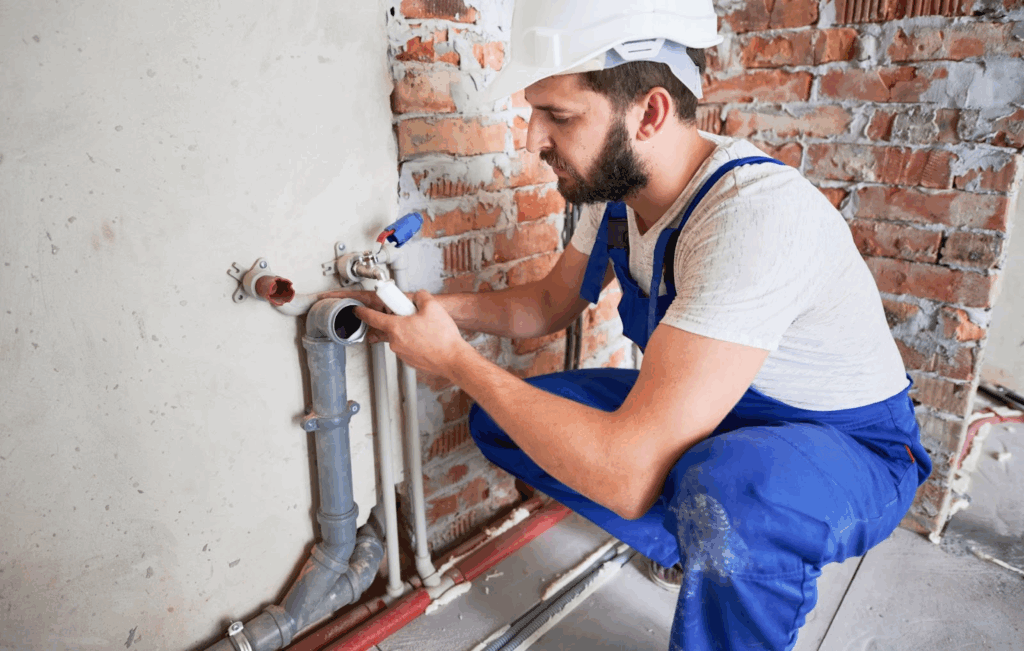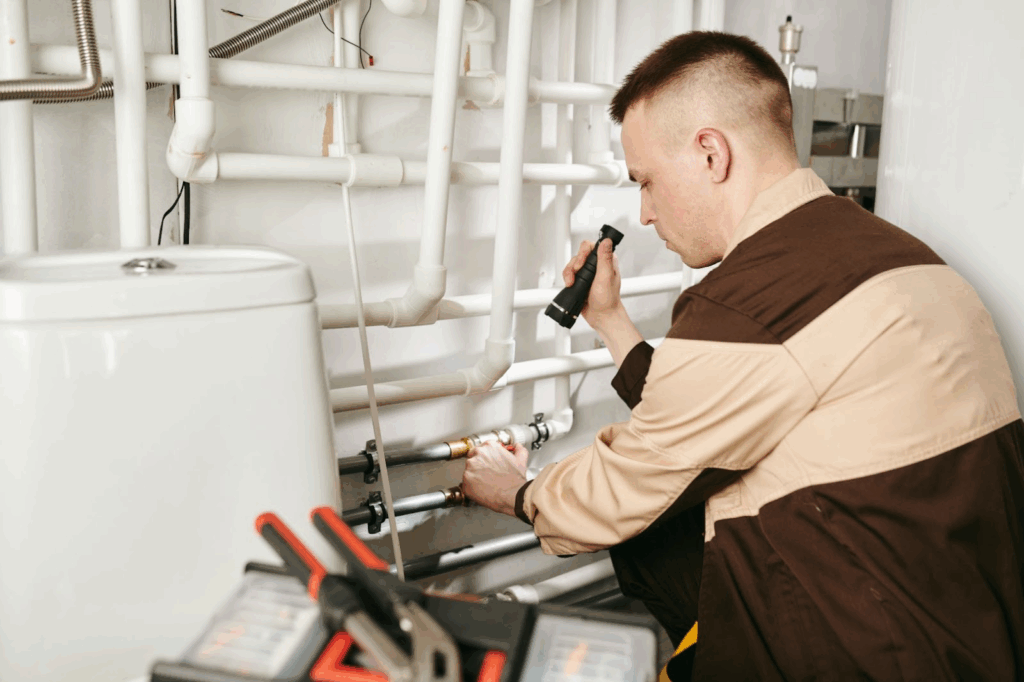Water damage doesn’t wait for a good time. One hidden leak can quietly ruin floors, walls, and budgets before you notice it. It starts small—maybe a rising water bill or a faint musty smell—but rarely stays that way. Ignoring the early signs turns a quick fix into a full-blown repair job. Spotting leaks early gives you control, saves money, and protects your peace of mind.
What is Plumbing Leak Detection?
Understanding what plumbing leak detection involves helps homeowners stay in control. It’s not just about spotting water under a sink. It’s about knowing the systems behind your walls and beneath your floors. Leaks can go unnoticed for weeks or even months, causing long-term damage.
Understanding the Basics
Plumbing leak detection means identifying hidden leaks in your water system. These leaks might be in walls, floors, ceilings, or underground. Some signs are visual, but many require tools to detect. Plumbers use devices that listen for sounds or sense moisture. Knowing where and how to look makes early detection possible.
Why Early Detection Matters
Leak waste water and raise your bill quickly. Worse, they can wreck drywall, rot woods, and spark mold growth. The longer a leak goes undetected, the more damage it causes. Structural issues from water damage cost far more than fixing a simple leak. Early leak detection avoids major repairs and keeps your home safe.
Common Signs of Hidden Plumbing Leaks
Leaks often hide behind walls or under floors. They don’t always leave puddles where you can see them. But they leave signs—if you know what to look for. Watching for small changes in your home helps catch problems before they grow:
Unusual Water Bills
A high water bill is one of the first signs of a hidden leak. Ask questions if your usage habits haven’t changed but your bill spikes. Compare your current bill to previous months or the same time last year. A slow leak adds up fast over 30 days. Even a dripping pipe wastes gallons each day.
Stains, Warped Walls, or Peeling Paint
Water behind walls causes damage visible from outside. You might notice dark stains, bubbling paint, or warped drywall. Ceilings may sag or show yellowish spots. These signs often appear near bathrooms or kitchens. If you see them, don’t wait—it likely means moisture is trapped behind the surface.
Musty Odors and Mold Growth
Mold needs moisture, and hidden leaks give it the perfect home. If you smell something earthy or musty, a leak might be feeding mold even after cleaning. Bathrooms, basements, and under sinks are common trouble spots. Check for black spots or fuzzy patches near the plumbing. Mold can spread fast and affect your air quality.
Water Meter and Valve Checks
Your water meter can help catch leaks early. First, shut off all water inside and outside your home. Then, watch the meter. If it still moves, water is leaking somewhere. Also, inspect valves under sinks and behind toilets. If they’re wet or corroded, you’ve likely got a slow leak.
Areas Most Prone to Plumbing Leaks
Leaks don’t happen randomly—they target weak points in your system. Some areas are more vulnerable than others. Familiar sources are high-usage zones, old fittings, and hidden pipes. Knowing where to look helps catch leaks before they become major problems:
Under Slabs and Foundations
Slab leaks occur in pipes buried beneath concrete foundations. They’re hard to detect because the damage happens below your feet. You might notice warm floors, damp carpets, or cracks in walls. These leaks often show up in older homes or areas with shifting soil. If ignored, slab leaks can damage your entire foundation.
Kitchens and Bathrooms
These rooms use the most water and have the most plumbing. Sinks, dishwashers, showers, and toilets connect to multiple pipes. Leaks often happen under sinks or behind walls. Look for water stains inside cabinets or soft spots in the flooring. Even a tiny drip can lead to mold or rot over time.

Laundry and Utility Rooms
Washing machine hoses and utility sinks wear out faster than other fixtures. Over time, vibrations and pressure changes can loosen connections. Inspect hoses and fittings for signs of wear or corrosion. Water around the base of machines or puddles near walls are early red flags. Regular checks in these rooms prevent more significant issues.
When to Call a Plumbing Leak Detection Specialist
Some leaks can be caught with simple checks, while others hide deep inside walls, floors, or foundations. If you’re unsure or keep seeing signs, it’s time to call in a professional. Plumbers have the right tools, experience, and training to find and fix leaks without guesswork.
DIY vs. Professional Detection
Homeowners can check meters, inspect fittings, and look for stains. However, advanced leaks often need expert tools and training. Acoustic or thermal imaging isn’t usually available at hardware stores. A professional can locate the exact source, saving time and money. It’s worth it when the damage risk is high or symptoms return.
What to Expect During a Leak Inspection
A plumbing inspection starts with a walkthrough and symptom check. The plumber asks about signs you’ve seen and areas you’re concerned about. Then, they use tools like meters or thermal cameras to scan the space. Some checks take an hour, and others take longer if it’s a complex system. The goal is always to find and fix the root cause fast.
Plumbing Leak Detection Tips for Homeowners
Prevention is more manageable than repairs. Good habits and regular checks go a long way. Leaks start small but don’t stay that way for long. Keeping a watchful eye helps avoid costly surprises.
Monitor Water Usage Regularly
Watch your water bill and usage month by month. If numbers jump without reason, check for leaks. You can also use apps and smart meters to track usage. Small daily leaks quickly add up over weeks. Regular monitoring gives you a warning before the damage shows up.
Insulate Pipes and Fix Drips Early
Cold weather makes pipes freeze and burst. Insulating pipes in exposed areas keeps water flowing and prevents cracks. Fix dripping faucets or loose connections as soon as you spot them. Even slow drips cause damage over time. Sealants and plumber’s tape can stop small leaks before they spread.
Schedule Annual Plumbing Checks
An annual plumbing inspection keeps your system in shape. A plumber checks for signs you might miss, like pressure drops or pipe corrosion. These checks catch problems early and help you plan repairs before they’re urgent. Think of it as a checkup for your home’s water system. It’s a small cost that prevents big problems.
Plumbing Leak Detection for Different Home Types
Leaks show up differently depending on the type of home. What works for a one-story house might not apply to an apartment or an older property. Understanding the differences helps homeowners know what to expect and where to look:
Leak Risks in Older Homes
Older homes often have outdated pipes, like galvanized steel or polybutylene. These materials corrode, crack, or fail more often. Leaks may start small but turn into significant bursts. Regular checks are necessary if your home is over 30 years old. Plumbing upgrades might be the only way to avoid future leaks.
Challenges in Multi-Unit Buildings
Leaks in condos or apartment buildings affect more than one unit. Water from a single leak can spread through walls or ceilings. Shared plumbing makes detection harder and slower. Tenants might ignore signs, assuming someone else will report it. Property managers should do regular inspections to catch issues early.

Seasonal Plumbing Leak Detection Tips
Weather affects your plumbing more than you think. Cold snaps, humidity, and heavy rain all increase leak risks. Knowing what to check each season helps you avoid costly repairs:
Winter Freeze and Pipe Bursts
Frozen pipes are a top cause of winter leaks. Water expands as it freezes, stressing pipes until they crack. Insulate exposed pipes in attics, basements, or crawl spaces. Let faucets drip during extreme cold to keep water moving. After a freeze, check for low water pressure—it could mean a pipe cracked.
Spring Thaw and Soil Shifting
When frozen ground thaws, it shifts—and so do underground pipes. Slab and mainline leaks often appear in spring. Watch for unexplained wet patches in your yard or a sudden pressure drop. Warmer weather also brings moisture inside, so monitor for mold or mildew in closed spaces.
Plumbing Leak Detection Tools and Technology
Plumbing professionals use advanced tools to find what eyes can’t see. These devices locate moisture, sounds, and temperature changes inside walls or under floors. Some tools are designed for specific types of leaks, while others work well in any situation. Knowing how these tools work shows why professional help can make a big difference:
Acoustic Listening Devices
These tools detect the sound of water escaping under pressure. Plumbers use them to listen through walls, floors, or concrete slabs. They’re invaluable for finding leaks in hard-to-reach areas. The device picks up vibrations from the pipe and amplifies leak sounds. It’s non-invasive and often catches what visual checks miss.
Infrared Thermal Imaging
Thermal cameras detect temperature changes caused by moisture. Wet spots cool differently than dry areas, creating visible heat patterns. Plumbers scan walls or floors to find moisture that hasn’t surfaced yet. This method is quick, safe, and very effective. It’s commonly used in homes with suspected behind-the-wall leaks.
Pressure Testing
Pressure tests check for drops in water pressure inside a plumbing system. Plumbers seal off parts of the system and pressurize them. If the pressure drops without visible leaks, something’s wrong inside. This method helps locate pipe failures, especially in older or complex homes. It’s often paired with other tools for accuracy.
Plumbing Leak Detection and Insurance Coverage
Many homeowners don’t know if their policy covers leak damage. The delicate print matters when you’re filing a claim. Understanding what insurance includes—and what it doesn’t—can save you a financial headache.
What’s Usually Covered
Most policies cover sudden and accidental leaks, like a burst pipe. That includes water damage repair and sometimes the cost to fix the leak itself. However, coverage can be denied if the leak is due to neglect or poor maintenance. That’s why early detection matters—not just for your home but also for your wallet.
How to Document and Report a Leak
Take photos of damage right away. Record dates and what you noticed. Contact your insurer as soon as possible and keep records of plumber visits. The more proof you have, the stronger your claim. Regular maintenance logs also help if you need to show that the damage wasn’t due to neglect.
Stay Ahead With Smart Plumbing Leak Detection
A leak isn’t just water—it’s stress, expense, and lost time. You don’t have to wait for damage to show up before you act. Every check you do and every inspection you schedule keeps your home one step ahead of disaster. Plumbing leak detection isn’t a chore—it’s a habit that protects everything you’ve built. The sooner you take it seriously, the longer your home stays dry, sound, and yours.
Want more ways to protect your home from hidden leaks? Visit Castaneda’s Plumbing and Rooter blog and learn to be smart about plumbing before problems start.

